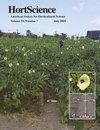施用氰氨化钙作为氮源对短日照洋葱的生长、产量、质量和贮藏耐久性的影响
IF 1.5
3区 农林科学
Q2 HORTICULTURE
引用次数: 0
摘要
土壤中可溶性氮(N)源的快速沥滤是农业实践中的一项重大挑战。因此,全面了解作物对缓释氮肥施用量的反应对优化农业氮肥管理策略具有重要意义。我们进行了一项田间研究,以调查播种前施氰氨化钙肥料对短日照洋葱的生长、产量、品质和货架期的影响。氰氨化钙(CaCN2,含氮 19.8%)分为 0、90、120、200、400 和 600 千克/公顷-1 CaCN2 六个等级,分别相当于 0、17.82、23.76、39.6、79.2 和 118.8 千克/公顷-1 N,重复施用四次,播撒到土壤顶部 5 至 10 厘米处。研究结果表明,使用 400 kg⋅ha-1 CaCN2 能显著改善洋葱生长的各项参数,如株高、叶片数、单株鳞茎重量、鳞茎直径、鳞茎长度和植株总重量。施用不同水平的 CaCN2 作为氮源对这些生长因素有显著影响。此外,研究还揭示了 CaCN2 施用水平与洋葱贮藏寿命之间的直接相关性。具体而言,研究结果表明,施用 400 kg⋅ha-1 CaCN2 可提高产量和洋葱植株的整体生长。然而,在室温下储藏 8 周期间,施用 600 kg⋅ha-1 CaCN2 会增加鳞茎失重、腐烂和发芽的发生率。这些研究结果为该地区的洋葱投资者和农民提供了有价值的见解,并为优化肥料使用和储藏方法以提高洋葱产量和减少收获后损失提供了实用建议。本文章由计算机程序翻译,如有差异,请以英文原文为准。
Impacts of Calcium Cyanamide Application as a Nitrogen Source on Growth, Yield, Quality, and Storage Durability of Short-day Onion
Rapid leaching of soluble nitrogen (N) sources in soil poses a significant challenge in agricultural practices. Therefore, gaining a comprehensive understanding of crop responses to slow-release N application rates has become crucial to contributing valuable insights to optimize N management strategies in agriculture. A field study was conducted to investigate the influence of preplant calcium cyanamide fertilizer on the growth, yield, quality, and shelf life of short-day onion. Six levels of calcium cyanamide (CaCN2, 19.8% N), 0, 90, 120, 200, 400, and 600 kg⋅ha−1 CaCN2, which are equivalent to 0, 17.82, 23.76, 39.6, 79.2, and 118.8 kg⋅ha−1 N, respectively, replicated four times were broadcasted and incorporated into the top 5 to 10 cm of soil. Using 400 kg⋅ha−1 of CaCN2 yielded noteworthy improvements in various parameters of onion growth, such as plant height, leaf count, bulb weight per plant, bulb diameter, bulb length, and overall plant weight, as indicated by the study results. The application of different levels of CaCN2 as an N source exerted a significant influence on these growth factors. Moreover, the study revealed a direct correlation between CaCN2 application levels and the storage life of onions. Specifically, the findings demonstrated that the application of 400 kg⋅ha−1 CaCN2 resulted in enhanced yield and overall onion plant growth. However, the application of 600 kg⋅ha−1 CaCN2 increased the incidences of bulb weight loss, rots, and sprouting during the 8-week storage period at room temperature. These findings provide valuable insights for onion investors and farmers in the region and offer practical recommendations for optimizing fertilizer use and storage practices to improve onion production and minimize postharvest losses.
求助全文
通过发布文献求助,成功后即可免费获取论文全文。
去求助
来源期刊

Hortscience
农林科学-园艺
CiteScore
3.00
自引率
10.50%
发文量
224
审稿时长
3 months
期刊介绍:
HortScience publishes horticultural information of interest to a broad array of horticulturists. Its goals are to apprise horticultural scientists and others interested in horticulture of scientific and industry developments and of significant research, education, or extension findings or methods.
 求助内容:
求助内容: 应助结果提醒方式:
应助结果提醒方式:


